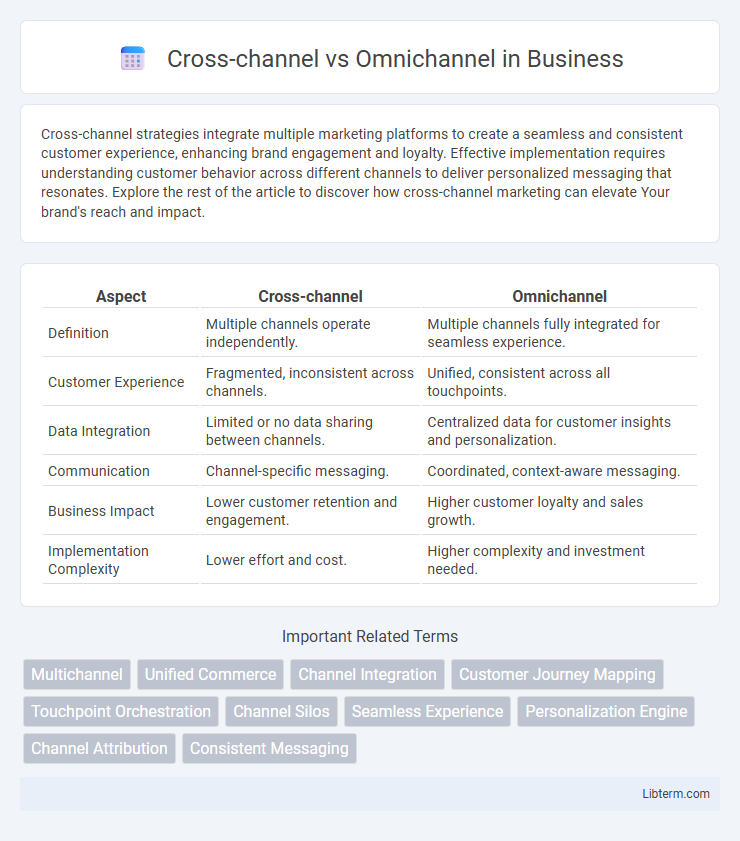Cross-channel strategies integrate multiple marketing platforms to create a seamless and consistent customer experience, enhancing brand engagement and loyalty. Effective implementation requires understanding customer behavior across different channels to deliver personalized messaging that resonates. Explore the rest of the article to discover how cross-channel marketing can elevate Your brand's reach and impact.
Table of Comparison
| Aspect | Cross-channel | Omnichannel |
|---|---|---|
| Definition | Multiple channels operate independently. | Multiple channels fully integrated for seamless experience. |
| Customer Experience | Fragmented, inconsistent across channels. | Unified, consistent across all touchpoints. |
| Data Integration | Limited or no data sharing between channels. | Centralized data for customer insights and personalization. |
| Communication | Channel-specific messaging. | Coordinated, context-aware messaging. |
| Business Impact | Lower customer retention and engagement. | Higher customer loyalty and sales growth. |
| Implementation Complexity | Lower effort and cost. | Higher complexity and investment needed. |
Introduction to Cross-channel and Omnichannel
Cross-channel marketing integrates multiple independent channels to reach customers, allowing interactions via email, social media, and in-store experiences separately. Omnichannel marketing creates a seamless, unified customer journey by synchronizing all channels, ensuring consistent messaging and personalized experiences across devices and platforms. Businesses adopting omnichannel strategies see higher engagement and customer loyalty compared to cross-channel approaches.
Defining Cross-channel Marketing
Cross-channel marketing involves using multiple marketing channels independently to reach customers, ensuring each channel operates as a distinct touchpoint without full integration. This approach allows businesses to engage audiences on platforms like email, social media, and physical stores but often leads to inconsistent customer experiences. Unlike omnichannel marketing, cross-channel lacks seamless coordination across channels, limiting the ability to deliver a unified brand message.
Understanding Omnichannel Marketing
Omnichannel marketing integrates multiple customer touchpoints, providing a seamless and consistent experience across all channels such as online, in-store, mobile apps, and social media. It goes beyond cross-channel marketing by prioritizing synchronization and personalization, leveraging data analytics and customer insights to create unified, targeted campaigns. This approach enhances customer engagement, brand loyalty, and conversion rates by delivering relevant content and interactions tailored to individual preferences and behaviors.
Key Differences Between Cross-channel and Omnichannel
Cross-channel marketing involves using multiple channels independently to reach customers, whereas omnichannel integrates these channels to provide a seamless and consistent customer experience. In cross-channel, interactions across platforms are disconnected, leading to potential gaps in customer engagement. Omnichannel strategy unifies data and communication across all touchpoints, enabling personalized and cohesive customer journeys.
Customer Journey: Cross-channel vs Omnichannel
Cross-channel strategies allow customers to interact with multiple channels independently, often resulting in fragmented experiences during the customer journey. Omnichannel approaches integrate these channels seamlessly, ensuring consistent and personalized touchpoints that enhance customer engagement and satisfaction. Businesses leveraging omnichannel frameworks see higher retention rates due to the unified customer journey across online, in-store, mobile, and social platforms.
Benefits of Cross-channel Strategies
Cross-channel strategies enhance customer engagement by seamlessly integrating multiple marketing platforms, enabling consistent messaging and personalized experiences. This approach improves data collection across channels, allowing businesses to better understand customer behavior and optimize campaigns for higher conversion rates. Cross-channel marketing also boosts sales and brand loyalty by providing customers with flexible and convenient interaction options across various touchpoints.
Advantages of Omnichannel Approaches
Omnichannel approaches offer seamless integration across multiple customer touchpoints, enhancing user experience by providing consistent messaging and personalized interactions. This strategy increases customer retention rates by allowing shoppers to switch effortlessly between channels while maintaining their preferences and shopping history. Data-driven insights gained from omnichannel systems enable businesses to optimize marketing efforts and improve overall operational efficiency.
Challenges in Cross-channel Implementation
Cross-channel implementation faces challenges such as inconsistent customer experiences due to fragmented data across platforms, leading to difficulty in tracking customer journeys effectively. Companies often struggle with integrating diverse sales channels and marketing tools, causing inefficiencies in communication and inventory management. Limited real-time data synchronization further hampers the ability to provide seamless interactions and personalized services across multiple touchpoints.
Overcoming Omnichannel Integration Barriers
Overcoming omnichannel integration barriers requires seamless data synchronization across multiple platforms to ensure a unified customer experience, unlike traditional cross-channel strategies that often operate in silos. Implementing advanced APIs and cloud-based solutions enhances real-time communication between channels, reducing latency and data discrepancies. Investing in robust customer relationship management (CRM) systems and staff training further bridges the gap between digital and physical touchpoints, optimizing omnichannel operational efficiency.
Choosing the Right Approach for Your Business
Cross-channel marketing leverages multiple channels independently to reach customers, while omnichannel integrates these channels for a seamless user experience across platforms. Businesses should assess customer behavior, budget, and technological capabilities to determine whether a cohesive omnichannel strategy or focused cross-channel efforts align best with their goals. Prioritizing data integration and consistent messaging enhances engagement and drives conversion regardless of the chosen approach.
Cross-channel Infographic

 libterm.com
libterm.com